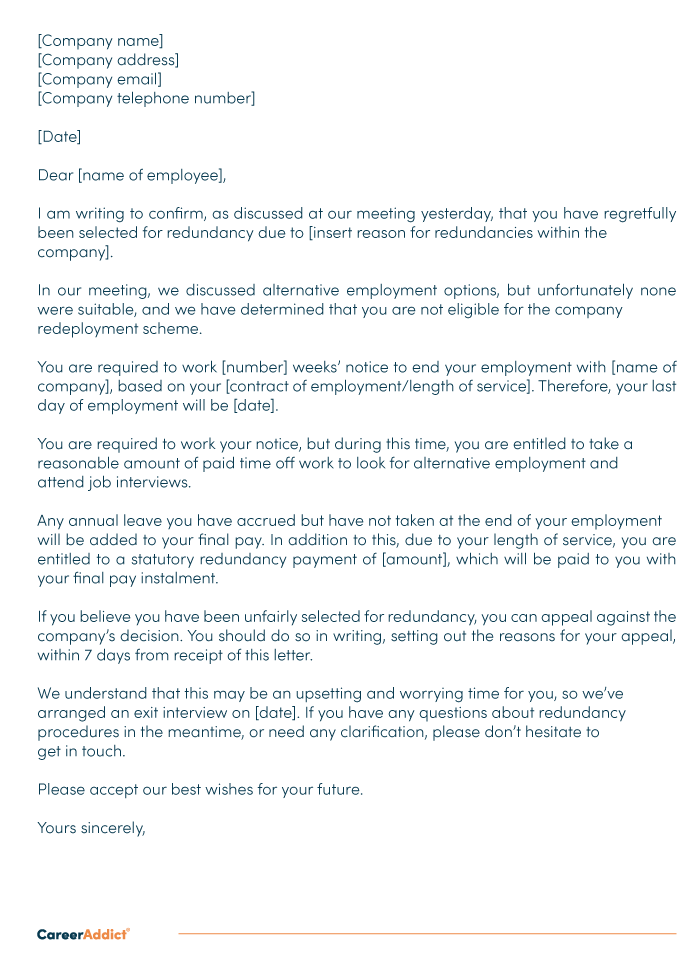Small Business Closing Employee Rights UK: Making Certain Fair Redundancy Pay
Small Business Closing Employee Rights UK: Making Certain Fair Redundancy Pay
Blog Article
Checking Out the Interplay In Between Business Redundancy and Organizational Flexibility for Future Growth
In the dynamic landscape of today's organization world, the complex partnership in between business redundancy and business versatility emerges as an essential element for sustained growth and success. Companies commonly face the obstacle of striking a fragile equilibrium between keeping a degree of redundancy to reduce dangers and promoting flexibility to react promptly to the ever-evolving market needs.
Importance of Company Redundancy
Firm redundancy is an important aspect that improves business durability and alleviates functional dangers. By including redundancy actions within the business structure, firms can much better hold up against unforeseen disruptions and variations in business environment. Redundancy offers as a strategic barrier, permitting firms to adjust and react efficiently to unexpected challenges without endangering important operations.
One trick facet of the value of business redundancy is its role in ensuring connection throughout times of situation. When faced with abrupt modifications or emergencies, redundant systems, sources, or workers can step in to maintain important functions and protect against prevalent interruptions. This continuity not just safeguards the company's reputation and customer trust fund however also minimizes economic losses and operational downtime.

Strategies for Business Adaptability

Developing versatile organizational structures that allow for fast adjustments to market dynamics and consumer demands is crucial for remaining affordable in a quickly developing environment. By proactively identifying possible interruptions and chances, organizations can proactively prosper and adapt in an ever-changing service landscape.
Harmonizing Redundancy and Versatility
Achieving an unified balance between functional redundancy and organizational adaptability is paramount in browsing the intricacies of a vibrant service environment. Redundancy within a firm supplies a safety and security web, making sure continuity and stability in procedures. Nevertheless, an excess of redundancy can cause inefficiencies and prevent versatility to altering market conditions. On the other hand, business adaptability enables firms to react quickly to exterior interruptions and confiscate new possibilities. Striking the right equilibrium in between redundancy and versatility is a delicate procedure that requires a deep understanding of the organization's objectives, industry dynamics, and threat tolerance.
To achieve this balance, business need to carry out normal analyses of their operations to determine areas where redundancy is needed for threat reduction and where versatility can drive technology and development. Implementing flexible frameworks, cultivating a society of continual discovering and improvement, and encouraging open communication throughout all degrees of the company are crucial methods to balance redundancy and versatility efficiently. By aligning these 2 critical elements, companies can position themselves for lasting development and success in an ever-changing service landscape.
Study on Adjustment Success
In examining circumstances of effective organizational adjustment, it comes to be obvious that the interplay in between functional redundancy and versatility is a defining variable in forming resilient companies. One compelling study is that of Netflix. Originally a DVD rental solution, Netflix demonstrated impressive flexibility by transitioning into a streaming system when digitalization interrupted the industry. By purposefully spending in innovation and content production, Netflix not just flourished yet made it through in a rapidly progressing market. Another standout instance is Amazon. Starting as an on the internet book shop, Amazon constantly adapted its service model, broadening into diverse fields such as cloud computing and fabricated intelligence. This adaptability allowed Amazon to remain ahead of competitors and fulfill changing consumer needs. Lastly, Adobe supplies a noteworthy picture of effective adaptation. The business changed from offering software licenses to a subscription-based design, making certain repeating earnings streams and enhanced client involvement. These case research studies emphasize the significance of operational redundancy paired with organizational versatility in cultivating long-term visit their website growth and competition.
Structure Strength for Future Development
Structure durability for future growth needs a critical placement of functional processes with market dynamics and emerging patterns. Business must adapt to changing settings by cultivating a society of adaptability, advancement, and continuous renovation. Strength involves not only recovering from problems but additionally proactively preparing for future challenges. One key facet of building strength is investing in durable risk management strategies to minimize prospective disruptions. This consists of situation planning, expanding supply chains, and creating contingency prepare for different contingencies (who pays redundancy money).
In addition, cultivating solid relationships with stakeholders, such as clients, employees, vendors, and the community, is necessary for maintaining and weathering uncertainties trust fund and support during stormy times. Efficient interaction and openness play an important duty in structure strength, as they help straighten assumptions and help with collaboration in navigating unpredictabilities.
Additionally, companies require to focus on learning and advancement campaigns to upskill employees and furnish them with the needed tools to adjust to altering circumstances. By buying their labor force, firms can enhance their adaptability and agility, eventually reinforcing their strength for lasting future development.
Conclusion

In the dynamic landscape of today's service globe, the elaborate partnership between business redundancy and business adaptability emerges as an essential element for sustained development and success. Companies typically encounter the challenge of striking a delicate equilibrium in between preserving a degree of redundancy to minimize risks and promoting flexibility to respond promptly to the ever-evolving market demands.To achieve this equilibrium, business require to carry out regular analyses of their procedures to recognize locations where redundancy is needed for danger mitigation and where versatility can drive advancement and growth.In final thought, the interplay in between business additional resources redundancy and business adaptability is critical for future growth. Building resilience through a mix of redundancy and versatility will make certain that firms are prepared for the obstacles of the future.
Report this page